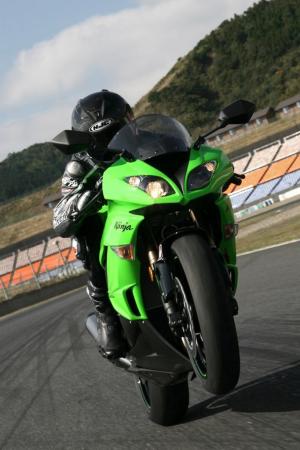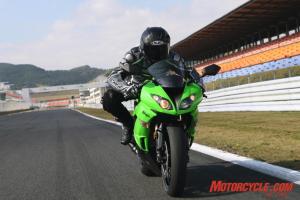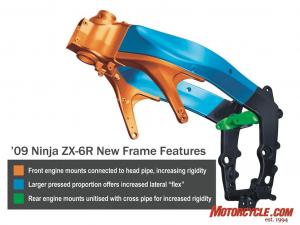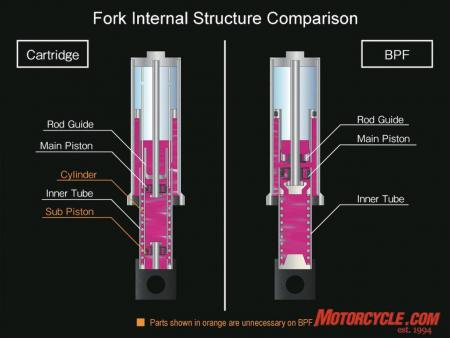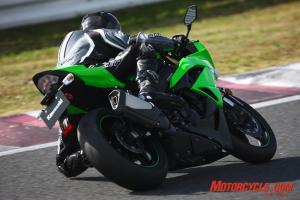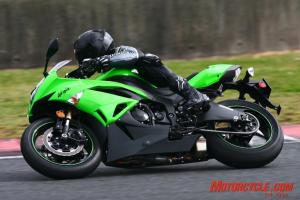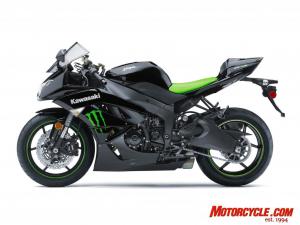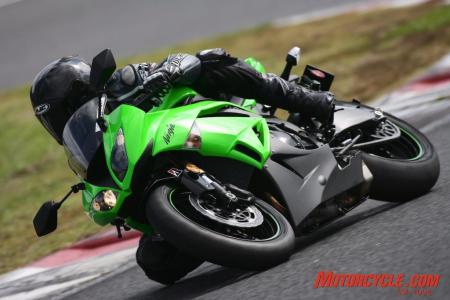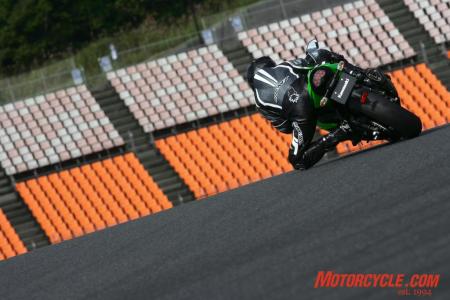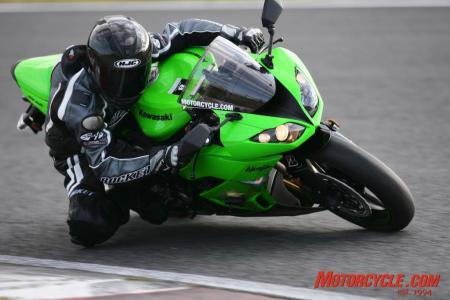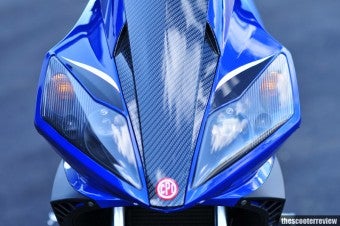In sportbike comparison, only the finest of lines separate a winner from an also-ran. The epitome of these indistinct distinctions surely must reside in the ultra-competitive four-cylinder 600cc class. In our 2008 Supersport Shootout, the Honda CBR stood at the head of the class for its light weight and mondo-midrange motor, while the Gixxer Suzuki finished close behind for its nearly complete lack of foibles. Yamaha's R6 excelled at the track. Meanwhile, the ZX-6R took class-leading votes in the more humble categories of brake and slipper-clutch performance and was let down by an engine that felt strangled at its upper end (see sidebar below).
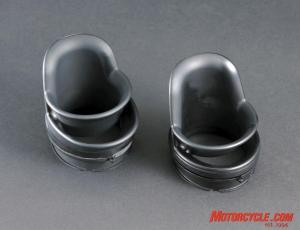
Here's a way to do a version of variable-length intakes but without the servo motors. Air draws mostly from the taller snorkels at lower revs, then is able to pull from the shorter inlets at quintuple rpm numbers.
As such, it's no surprise to see this new edition of ZX-6R with several tweaks to its modest motor. It begins with several modifications to the intake system of the injected engine. From the airbox, Kawi fitted new double-bore intake funnels that are a simpler form of the variable-length intakes on Yamaha sportbikes. These velocity stacks have inlets at two different (but static) heights, with the taller inlet boosting midrange power while the short stack maximizes top-end production.
Combustion efficiency is aided by new cylindrical guides at the top of the air cleaner to direct more accurately sprayed fuel from the secondary injectors. The distance between the dual throttle plates of the 38mm oval-bore throttle bodies has been lengthened 10mm for a smoother transition through to the revised cylinder-head porting.
| Hidden Horsepower The 2007-8 ZX-6R was held back most in shootouts by the underwhelming boogie from its powerplant. It was dead last in the horsepower competition with a lowly 97.7 ponies at 12,600 rpm, and it beat only the peaky R6 in midrange power. To meet American noise requirements, its exhaust valve closes as the engine is reaching for its power peak. Sadly, it signs off by 13,000 rpm, far short of its 15,600-rpm rev limit. However, the bike's computer can be tricked into reverting to the less-restrictive tuning of the European market Ninjas by bridging a wire in an electrical connector. We outlined how to do the mod in our Supersport Shootout sidebar. With the jump made and now keeping its exhaust valve fully open at high rpm, horsepower jumped to nearly 103 hp at 14,000 revs, much more competitive with its rivals.
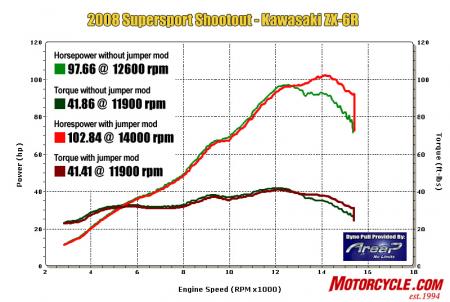 In stock form, the ZX-6R runs out of breath at high revs, but the ECU jumper mod lets it run like it should. In modified form, it posted a 5-horse boost in horsepower and a much more usable over-rev zone. For 2009, U.S.-spec ZXs again have this exhaust-restriction ECU programming, but this time we're told there are only 2 hp missing from the free-revving Euro model. Kawi claims an 8-hp boost in power with this new model, which should translate into about 104 rear-wheel horses at the top end, competitive with its rivals. Now, if we could again find the right wires to cross, we might find a new class leader... |
Other engine upgrades include more powerful stick coils for the ignition, revised piston profiles with a molybdenum coating on their skirts and lower-friction piston rings. The titanium exhaust system begins with its four header pipes using crossover tubes for lower-end scavenging before it flows to a four-into-one collector. A catalyzer-equipped under-engine chamber eventually flows to a stylized side-mount muffler. It adds up to a claimed 124 crankshaft horsepower (116 previous) at 13,500 rpm, and 130 hp with full ram-air effect. It's now down just 2 hp from the Euro model, and we expect about 105 horses at the rear wheel.
The Ninja piles on speed at a clip worthy of what seems to be class-competitive power...
And that's about how the newest ZX felt at the Kawasaki-owned Autopolis Speedway in Japan where we had two days in which to stretch the Ninja's throttle cables. Autopolis was designed by the project leader for Honda's F1 team in the 1960s, boasting a fast and fun mix of corners that bend their way over hills for nearly 3 miles. The course winds up and down a total of 52 meters during its 20 turns.
More to the point is Autopolis' half-mile long front straight. The new ZX pulls itself strongly from the top of second gear entering the straight, followed quickly by third gear and the rest of them in the smooth-shifting six-speed cassette transmission. The Ninja feels most impressive in it upper middle range, with revs climbing swiftly from 9000-15,000 rpm. And it sounds mega coming down the main straight at Autopolis, with a menacing intake howl followed by the scream of stratospheric rpm raising the pulse of all motorheads within earshot.The Ninja piles on speed at a clip worthy of what seems to be class-competitive power, keeping in mind Autopolis is located at an elevation of about 3000 feet, reducing performance from the thicker air nearer sea level. The ZX feels much livelier than last year's bike, considering the track's altitude. Power eventually tapers off by an indicated 15K, so there's no need to take it to its 16.5K redline. Further evidence of this was the top speed indicated on the front straight registered 152 then 151 when letting the bike rev out in fifth gear. When upshifting to sixth, speeds climbed continually to 154 mph. It's notable that this info is easy to read on the bike's new digital instruments that include a handy and legible gear-position indicator.
Getting that speed scrubbed off for Turn 1 is a set of brakes pleasingly unchanged from the best-in-class binders on the previous model. It's got all the trick stuff like radial-pump master cylinder, radial calipers and wavy rotors and, despite the moderately sized 300mm discs, perform as good as any sportbike brakes on the market (a hefty thickness 6.0mm instead of a more typical 4.5-5.0mm keep fade at bay). I can't imagine brakes working any better than these, offering excellent feel at the lever and mondo power. A 220mm rear disc is 10mm larger in diameter and its lever has a new pivot mount, but there wasn't much call for their use on the track.
So far, so good, but it gets unexpectedly better when the 6R is torqued into a turn. Instead of the somewhat lazy response from the old 25-degree rake angle, the '09 edition carves immediately into an arc with the best of them, as its rake sharpens to a more typical 24.0 degrees. Trail receives a corresponding decrease from 110mm to 103mm to add up to a dexterous sporting scalpel. Quelling possible instability issues is a standard-equipment Ohlins steering damper like seen on the 10R.
The Ninja's turning prowess is accentuated with some major modifications to what seems to be an unchanged aluminum frame. To enhance overall rigidity, the front engine mounts are now welded to the steering head structure, while a cross pipe now reinforces the rear of the frame. Chassis designer Hiroshi Tamura told Motorcycle.com that there have been many subtle changes to the shape of the main spars in an effort to gain back some lateral flex that is desirable for feedback and shock absorption while leaned over. In a conversation with Kawasaki test rider Shigeru Yamashita, he told us there were three major frame variations that were tested, plus several versions with smaller changes. Roll response has also been increased by rotating the engine 16mm upward for a higher C of G.
One of the greatest enemies of high performance is weight. The 6R is said to be 22 lbs lighter than last year. (Although it might not seem like it from the bike's 421-lb weight in the spec chart. Japanese OEMs have now agreed to state their bikes' weight in terms of a fueled, ready-to-ride form instead of the bogus "dry weights" they formerly tried to deceive us with.) Many pounds were trimmed from the chassis, and the sharper new bodywork and lighter fenders save about 3 lbs. The engine, despite being architecturally identical, also went to Jenny Craig, losing nearly a pound from the double overhead camshafts and about 1.5 lbs from the use of magnesium engine covers.
One critical area of weight adjustment was losing the undertail exhaust from the old ZX. Kawi says the new titanium exhaust system of the Ninja is nearly 2 lbs lighter, but just as important is losing the muffler formerly mounted under the seat and far away from the bike's C of G.
Fresh to the market is Showa's new Big Piston Fork. This design (also to be seen in the '09 GSX-R1000) swaps a large 37mm main piston in place of the previous 20mm slug, thereby offering 3.4 times the surface area. Kawi says the new 41mm fork provides the same damping force with less than one-third the damping pressure. And, by eliminating the cartridge tub and sub-piston, the BPF uses less components and is 370 grams lighter.
Nice numbers, it seems, and it feels like an improvement through the handlebars. Kawasaki claims an increase in feel during the initial stroke, with a reduction in pitching while braking and better control of rebound damping. More than a slightly silly name, it offers excellent control without harshness, and feedback is exemplary. Damping rates are made easily from fork-top adjusters for compression and rebound, while a hex key changes spring preload at the bottom of the fork leg. The rear shock remains basically unchanged, still with dual-speed compression-damping adjusters.
Further aiding feedback are a few ergonomic tweaks. The ZX6R's clip-on handlebars (280g lighter) are closer to the rider and tilted slightly inward, making for less of a reach and a more comfortable stance. A rider's forearms touch the ZX-10R-like fuel tank when hanging off, adding to communication from the bike. Not only is the 4.5-gallon tank slimmer, so is the saddle which is also 5mm lower (to 32.4 inches) and shorter front to back.By the end of our sessions on Day 1, we had mostly figured out the challenging and thrilling Autopolis and had found a reasonably quick pace on the responsive Ninja. On Day 2, Kawi techs upped the shock's preload which alleviated the rear end from squatting under acceleration. Adding one additional click of rebound damping made it feel fully sorted during the following session. Later, an additional turn of front preload increased front-end feedback and allowed higher-G braking. Even with inch-long footpeg feelers and grippy Bridgestone BT-003 tires, ground clearance was rarely an issue and wouldn't be with the hero blobs unscrewed.
On a more subjective note, we believe the styling of the new Ninja to be a major improvement. The previous bike was like lime-flavored vanilla, but this new one is an aggressive wasabi-tinged pistachio. Angles are sharply cut, and the new exhaust creates space between the rear wheel and tailsection. The nose of the ZX slopes forward in a beak-like fashion, with narrow-set headlights more visually appealing than the similar design of the ZX-10R. Thankfully, the 600cc ZX loses the 10R's mirror-stalk-mount turnsignals in favor of signals integrated into the leading edge of the side fairings.
The U.S. market will see four color schemes. An MSRP of $9,799 will get your choice of Metallic Diablo Black, Candy Surf Blue or the Lime Green version we tested. An extra $200 buys the special Monster Energy version, which along with the Lime Green bike, receives the clear-coated green stripes around the circumference of the wheels.
As a package, the new ZX-6R (or ZX600R9F, as it's called internally) is difficult to assess because of its faultless manners on the racetrack. It now turns in as quick as anything in its class, feedback is abundant, and its unchanged slipper clutch remains the benchmark - a rider can just throw away the clutch on downshifts without blipping the throttle. Its brakes are stellar, and its engine seems to be up to the class standards, even if the punchy CBR600RR (with more torque for'09!) might still hold a midrange advantage. And the Kawi's engine has impeccable throttle response, with on/off throttle transitions being as smooth as we've felt from a fuel-injected bike.
So what's to bitch about? Not much! It's infrequent for me to not ask for more power, and that was also the case in the relatively thin air of Autopolis. What else? Well, I wasn't impressed that my Alpinestars had scuffed a noticeable mark into the left side of the asymmetrical ZX-10R-derived new swingarm. Finally, is it just me or does nearly $10,000 seem pricey for a middleweight sportbike (even if the Kawi is priced competitively with its competition)?
Bottom line: If you have an '07-08 ZX, you might want to trade it in. If you have another brand's 600cc sportbike, keep an eye on your mirrors.
| Highs: | | Sighs: |
- Sharper steering
- Sharper styling
- Sharper dyno chart
| - Still not the belle of the ball
- Boots scuff swingarm
- Where's the 636cc version?
|
|
| Duke's Duds |
- Lid: HJC FS-15
- Skin: Joe Rocket Speedmaster 5.0
- Gloves: Shift Vertex
- Boots: Alpinestars Supertech R
|
Related Reading:
Kawasaki Japan Tour
2007 Kawasaki Ninja ZX-6R Full Report
2008 Supersport Shootout
2009 Kawasaki Motorcycles Released



